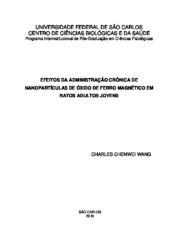Efeitos da administração crônica de nanopartículas de óxido de ferro magnético em ratos adultos jovens
Abstract
The fast development of the nanotechnology, and the use of this technology to develop new products to help in diagnosis diseases, drugs and treatments for many diseases is increasing. Some authors have been warning about the nanoparticles use, because the real affect, toxic or not, still unknown. Iron oxide nanoparticles have been used in contrast liquid for magnetic resonance imaging, cancer treatment, among others. The aim of this work was to analyze the possible effects of chronic treatment with these nanoparticles in adults rats. The animals were distributed in 3 groups: Control (saline 0.9% - 0.1 mL/100 of body weight), nFe 0.3 (magnetic iron oxide nanoparticles 0.3 mg/kg BW) and nFe 0.6 (magnetic iron oxide nanoparticles 0.6 mg/kg BW). The animals were treated by gastric gavage during 8 weeks, 5 days per week. The body weight of the animals from the nFe 0.6 group decreased when compared to animals from the control group, and the BW of the animals from nFe 0.3 group was not different from the control group. The animals from the nFe 0.6 group showed the higher blood levels of cholesterol, although the levels of glucose, urea, creatinine, AST, ALT and alkaline phosphatase, plus hematology were not different from the animals of control group. Moreover, the seminal gland and ventral prostate of the animals of nFe 0.6 were atrophied. All those parameters of animals from nFe 0.3 group were not different compared to control group. The bone (femur and vertebra) biometric, biomechanical and biophysical parameters were similar in the animals from the different experimental groups. These results showed that high concentrations of magnetic iron oxide nanoparticles could be toxic and dangerous to the rats when take daily, but in low concentration it could be safe.
